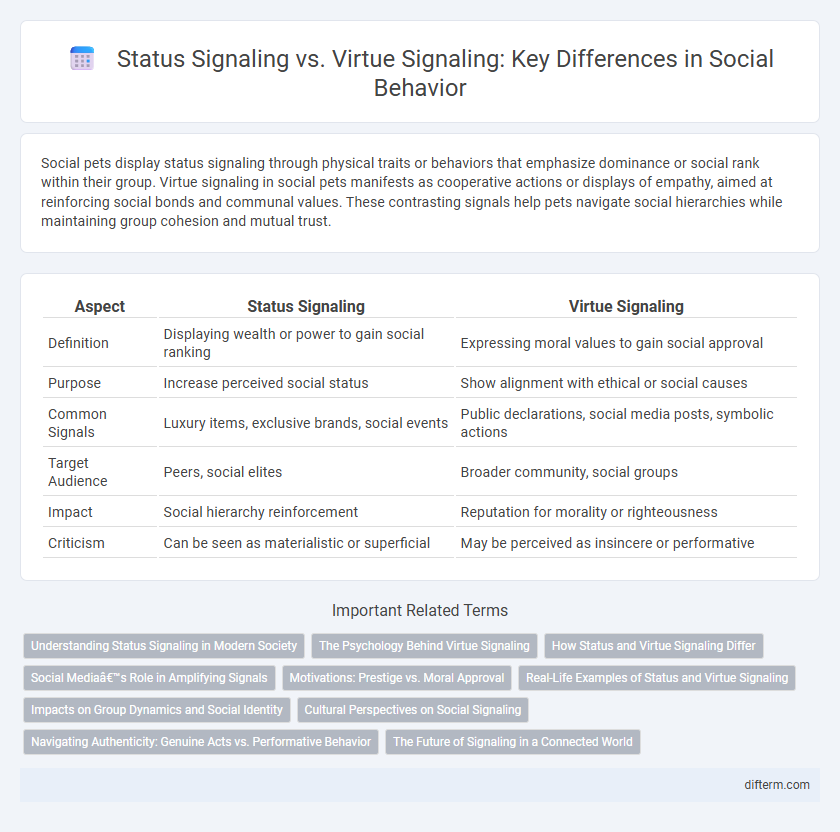Social pets display status signaling through physical traits or behaviors that emphasize dominance or social rank within their group. Virtue signaling in social pets manifests as cooperative actions or displays of empathy, aimed at reinforcing social bonds and communal values. These contrasting signals help pets navigate social hierarchies while maintaining group cohesion and mutual trust.
Table of Comparison
| Aspect | Status Signaling | Virtue Signaling |
|---|---|---|
| Definition | Displaying wealth or power to gain social ranking | Expressing moral values to gain social approval |
| Purpose | Increase perceived social status | Show alignment with ethical or social causes |
| Common Signals | Luxury items, exclusive brands, social events | Public declarations, social media posts, symbolic actions |
| Target Audience | Peers, social elites | Broader community, social groups |
| Impact | Social hierarchy reinforcement | Reputation for morality or righteousness |
| Criticism | Can be seen as materialistic or superficial | May be perceived as insincere or performative |
Understanding Status Signaling in Modern Society
Status signaling in modern society involves individuals displaying markers of wealth, power, or prestige to communicate their social rank, often through luxury goods, exclusive experiences, or professional achievements. This behavior contrasts with virtue signaling, which emphasizes moral values and social justice causes to gain approval or social standing within certain communities. Recognizing these differences aids in interpreting social dynamics where status is conveyed through tangible symbols rather than solely through ethical positioning.
The Psychology Behind Virtue Signaling
Virtue signaling involves individuals publicly expressing moral values to gain social approval or enhance self-image, often rooted in the desire for social belonging and identity reinforcement. Psychological theories highlight that this behavior is driven by intrinsic needs for social validation and a sense of moral superiority. Understanding the cognitive mechanisms behind virtue signaling reveals how people navigate social dynamics by aligning with group norms and ethical ideals.
How Status and Virtue Signaling Differ
Status signaling communicates social rank and wealth through material possessions or exclusive experiences, emphasizing outward displays of power and prestige. Virtue signaling conveys moral values and ethical stances, often through public declarations or symbolic actions to demonstrate social awareness or alignment with a cause. The key difference lies in status signaling's focus on external social hierarchy, while virtue signaling centers on expressing personal or group ethics.
Social Media’s Role in Amplifying Signals
Social media platforms intensify status signaling by enabling users to showcase wealth, lifestyle, and exclusivity through curated posts and luxury brand endorsements. Virtue signaling is amplified as individuals publicly express moral stances and social justice support to align with peer values and gain social approval. Algorithms prioritize engagement-driven content, further magnifying both status and virtue signals to wide audiences.
Motivations: Prestige vs. Moral Approval
Status signaling primarily derives from the desire for prestige, where individuals display wealth, luxury, or exclusive experiences to assert social rank and gain admiration within hierarchical networks. Virtue signaling, in contrast, is motivated by seeking moral approval by publicly endorsing ethical values or causes, aiming to enhance one's reputation as a morally conscientious member of a community. Both forms of signaling leverage social visibility but target different social rewards: tangible status recognition versus intangible moral validation.
Real-Life Examples of Status and Virtue Signaling
Luxury brand logos on handbags and sports cars serve as clear examples of status signaling, visibly demonstrating wealth and social rank. Conversely, virtue signaling often emerges through public displays of social or environmental activism, such as sharing posts about charitable causes or participating in protests to highlight moral values. Influencers endorsing sustainable products can blur lines between status and virtue signaling, emphasizing social approval through ethical consumption.
Impacts on Group Dynamics and Social Identity
Status signaling often strengthens hierarchical structures within groups by emphasizing dominance and social rank, which can lead to competition and exclusion. Virtue signaling tends to promote group cohesion and shared moral values, reinforcing collective identity and encouraging inclusive behaviors. Both forms of signaling significantly shape social identity by influencing how individuals perceive themselves and others in group contexts.
Cultural Perspectives on Social Signaling
Cultural perspectives on social signaling reveal that status signaling often emphasizes wealth, power, and social rank as indicators of success, whereas virtue signaling typically highlights moral values, ethical commitments, and social justice concerns. In collectivist societies, virtue signaling may be more prominent as it reinforces community values and group cohesion, while individualistic cultures tend to prioritize status signaling to assert personal achievement and social dominance. These variations demonstrate how cultural norms shape the expression and interpretation of social signals, influencing social behavior and group dynamics globally.
Navigating Authenticity: Genuine Acts vs. Performative Behavior
Status signaling often involves conspicuous consumption or displays aimed at elevating social standing, whereas virtue signaling emphasizes expressing moral values to gain social approval. Authenticity in social behavior is marked by consistent actions aligned with personal beliefs, contrasting with performative behavior that prioritizes external validation over genuine intent. Navigating these dynamics requires critical self-awareness and discerning motives behind public expressions to foster true social connection.
The Future of Signaling in a Connected World
Status signaling will evolve as digital identity platforms integrate with social media, enabling more nuanced expressions of personal achievements and social standing. Virtue signaling may shift towards demonstrable impact through blockchain-verified philanthropy and eco-friendly actions, enhancing authenticity. Advances in AI-driven analytics will enable real-time detection of signaling patterns, influencing social dynamics and digital reputation management.
status signaling vs virtue signaling Infographic

 difterm.com
difterm.com